I played Hollinwell again a couple of weeks ago, the second time in two weeks, and it seems to me that even though I’ve always loved the course, it is really pushing to be my favourite… Plenty of history, both with regards to the club and the architecture, the feel of the club is old fashioned enough to give it real character, but without being stuffy, and the course? Well, there is plenty of variety to keep you interested and the challenge, though it is a stiff one, is far from impossible. Also, the course is set within some 600 acres, well more than average for a single golf course, and this means that at times there really is a feel of seclusion and retreat from everyday life rushing bye. And to top it all off, that such a course of this calibre is only half an hours drive from my house, really makes it a winner!
Firstly, let’s just clarify the name thing here. I myself refer to it as both Notts and Hollinwell but which is it? The club is Notts GC but the course is known as Hollinwell. I’m taking this to be similar say to the Honourable Company of Edinburgh Golfers who play their golf at Muirfield, so for the purposes of this post I’m going to refer to it as Hollinwell but I may occasionally refer to it as Notts, much as one would pretty much always refer to it as Muirfield but occasionally slip in a reference to the HCEG to spice things up a bit or to look more sophisticated!
I shall give a brief history of the course here, but some time soon I hope to write a more in depth history of the club for the Tournament Programme of a competition I am helping to organise at Hollinwell later in the year. When I do, I shall add it to this thread.
Notts GC moved to Hollinwell from their previous course at Bulwell Forest just north of Nottingham, in November of 1901. The course was originally laid out by Willie Park Jnr. However only about a year later JH Taylor was consulted with regards to the bunkering of the course, which may well have had something to do with the ever increasing advances in golf ball technology at the time? This course was the one Darwin played in his “The Golf Courses of the British Isles”, but in 1912 Tommy Williamson’s scheme of improvements was adopted, in an attempt to reduce the climbs involved in some of the hillier parts of the course, most notably the addition of the 3 new holes to the west of the entrance driveway and the addition of the new downhill par 3 thirteenth. More recently the club has undergone a major renovation programme, rumoured to be part of an attempt to entice the Walker Cup to the course. This has added length to the course and moved or rebuilt most of the bunkers, helping to tie them back into the surrounding landscape better, while stiffening the challenge for the better player. Other recent works have included large areas of tree and bracken removal in an attempt to return the land to its heathland origins.
Before I left to play this time, I did a bit of a search on here and other than Ran’s review and a picture essay by the ever reliable Mr Arble, there wasn’t much, and the photos were few and far between, so I decided to take my camera in an attempt to improve on the picture situation. I was though thwarted by the ever changeable weather in this wonderful country, so I’ve had to tweak a few as they were so dark, so apologies if a few look a little odd!
This time around I was lucky enough to be playing with a low single figure handicap member who suggested we play off the blue tees that stretch the course to well over 7,000 yards, so I’ve listed those yardages and the yellows that would be more likely to be played by a visitor.
Hole 1, par 4Blue 381 yards
Yellow 351 yards
Many see this as a rather bland and disappointing opening hole, however I don’t mind it at all. It’s usually played into the wind which can give it a little extra bite and the fairway bunkers on both sides at approx 240 out mean you often ease your way into the round with a fairway wood from the tee. To be honest, we are going to be challenged enough around Notts that I certainly have no problem with this opening hole! This is the view from the tee, right next to the entrance drive outside the pro shop and clubhouse
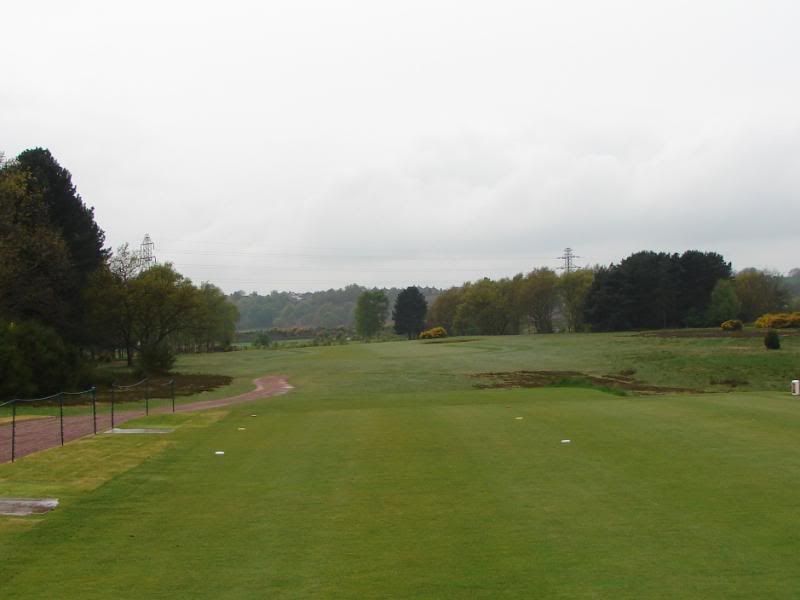
The second is played to a green with bunkers left and right. Many people may remember a large number of trees, mainly silver birch as I recall, to the back of the green. Our host for the day informed us that due to the electric cables running over the back of the green, the area beneath the cables had to be kept clear, so the club recently cut back all these trees. This is the view of the approach
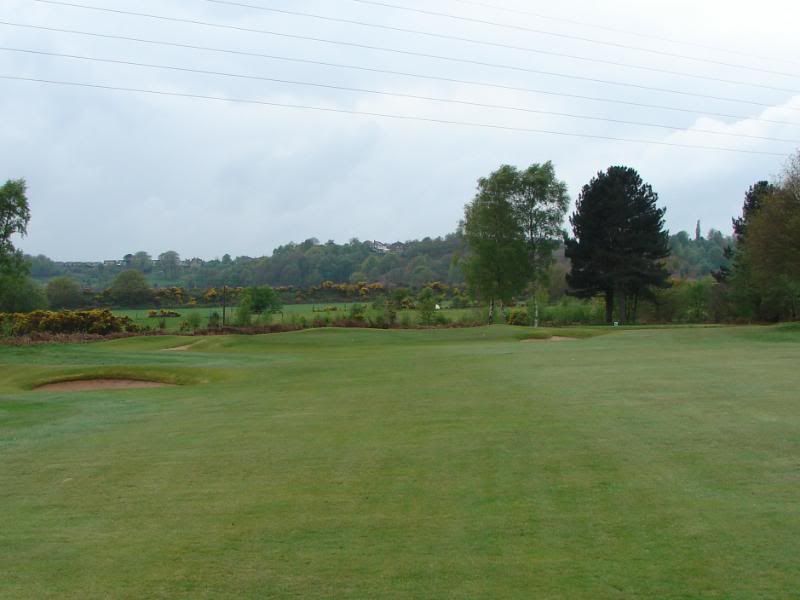 Hole 2, par 4
Hole 2, par 4Blue 462 yards
Yellow 413 yards
This is one of the real stand out holes! A long par 4 that doglegs to the left, to a green sitting in the crook of the hill, beneath “Robin Hood’s Seat”. The blue tees used to be with the white and the yellows at around 428 yards here, but the tree clearance behind the first has allowed for a new blue tee which now stretches the hole to 462 yards. This makes for a challenging drive, if you can hug the heather and bunkers with your tee shot, you have a shorter easier line in though it will be slightly blind, where as if you go further away from the bunkers you can get a glimpse of the green but the shot is much longer, and you run the risk of running through the fairway.
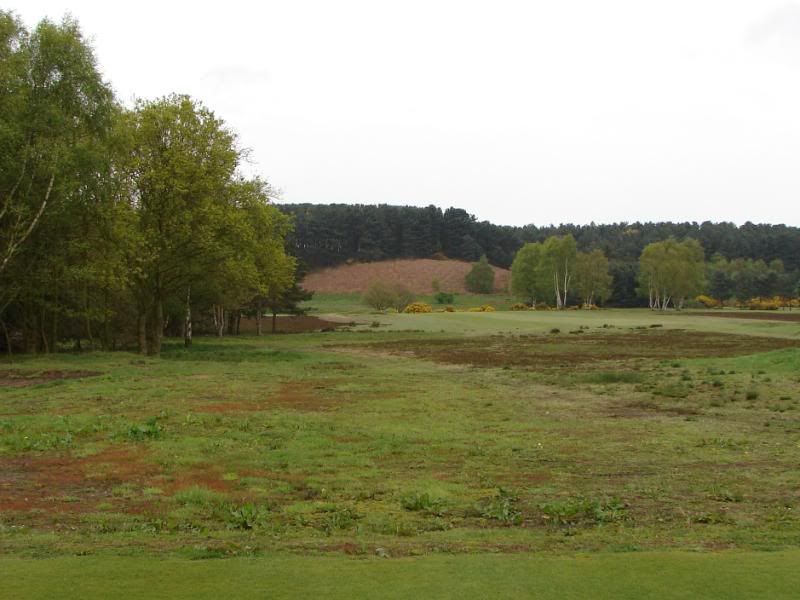
This is the view from next to the bunkers, you can just see the little white flag in the distance. Plenty of room to run a ball in from the left, though you need to be brave hitting over the corner of the heather and bracken covered hillside.
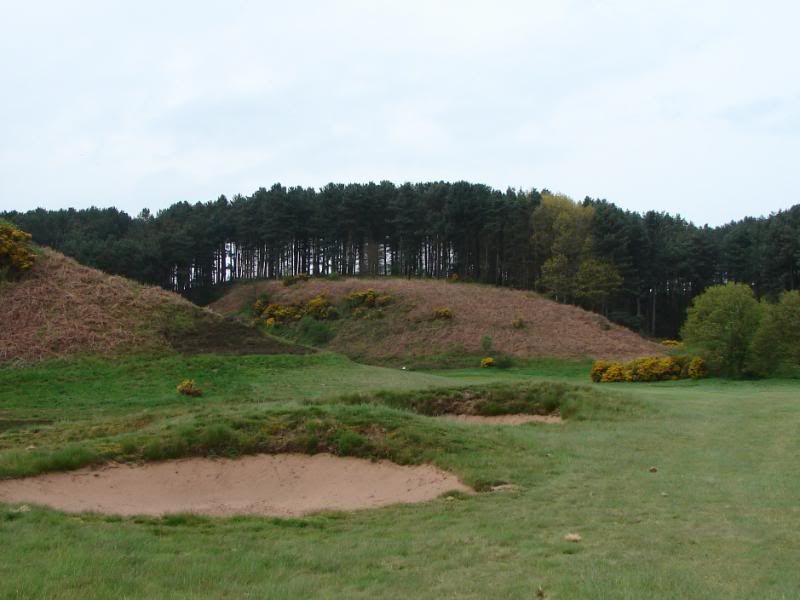
From a little further past the bunkers you begin to see how the green nestles in between the hillsides. This is the part known as “Robin Hood’s seat” where the legendary outlaw is said to have sat on look out for the sheriffs men approaching. I always used to think it was the hillside behind the green, with a small rock outcrop, but there is a picture in the clubhouse scrapbook which shows it to be the hillside to the left, which would indeed give a view towards Nottingham
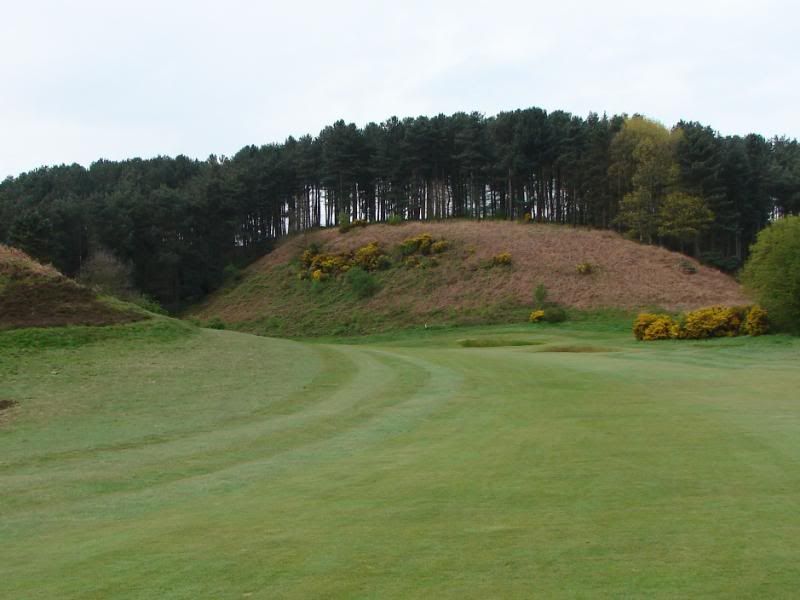 Edit August09: Here is an alternative picture of the approach to the second green. This picture and a few others I'll add, show how the gorse is now dormant while the long grass and heather have become dormant.
Edit August09: Here is an alternative picture of the approach to the second green. This picture and a few others I'll add, show how the gorse is now dormant while the long grass and heather have become dormant.
 Hole 3, par 5
Hole 3, par 5Blue 547 yards
Yellow 482 yards
You now turn back downhill towards the clubhouse to complete the triangle of holes to the west of the entrance drive, added in 1912. The back blue tee is set right up in the hillside and makes quite a difference to the drive. From the yellows I have always been able to get over the ridge about 220 yards out and then get plenty of run that brings the green within range in two easily. From the back tee though this ridge is over 280 yards away, and I could only just get up to the bunker!
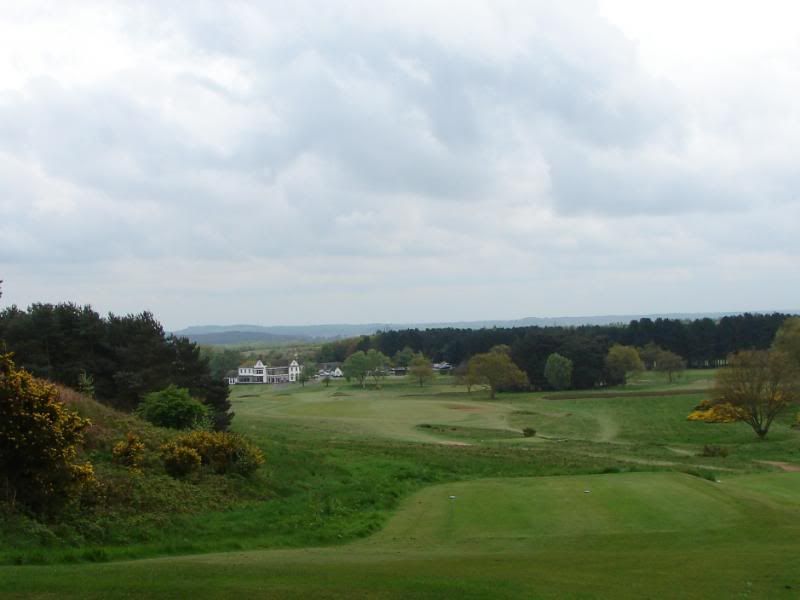
The choice, as Ran explains well in his rightup, is that if you lay up it should be short left of the bunkers as if you try and squeeze one in short and right, you then have to pitch, chip or putt through a small hollow and the entrance road is only just behind the green from that narrower angle. If you lay up short left, then it’s an easy pitch over the bunkers up the length of the green. A great setting just in front of the clubhouse
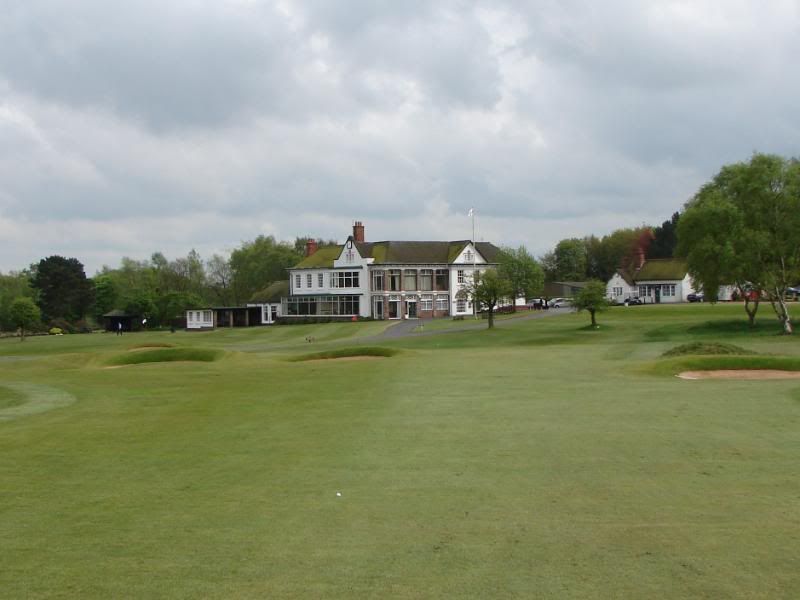 Hole 4, par 4
Hole 4, par 4Blue 454 yards
Yellow 429 yards
This tough par 4 was originally the first hole as Willie Park Jnr. designed the course, and it’s also used as the playoff hole for Open Qualifying here. The water hazard in front of the tee, which is also just off the left of the 18th fairway, was originally a small stream, created to get rid of a very wet area here some years ago. Also the left fairway bunker used to be about 50 yards shorter than its present position but was recently moved.
Edit August09: New picture of tee shot.
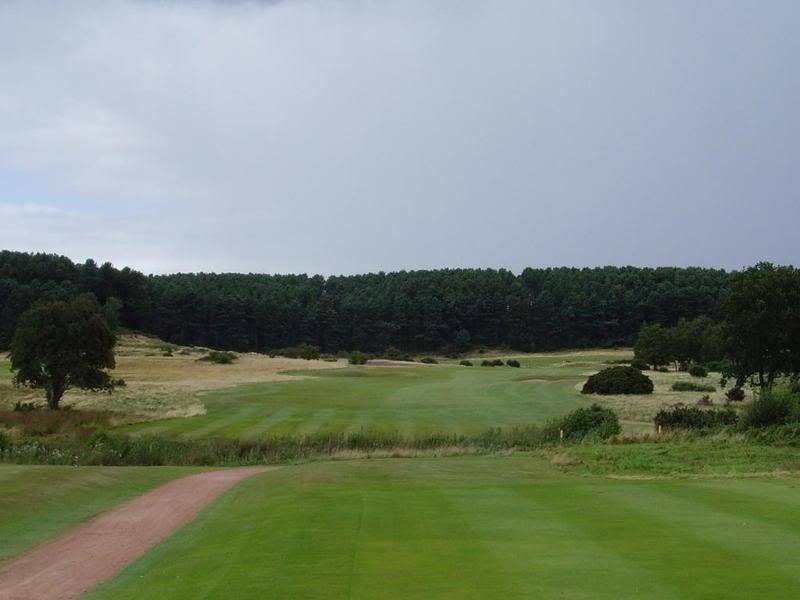
Here is the view of the approach. The cross bunker certainly comes into play for anyone who finds the rough and needs to hack out. You can see the 17th fairway running behind the green.
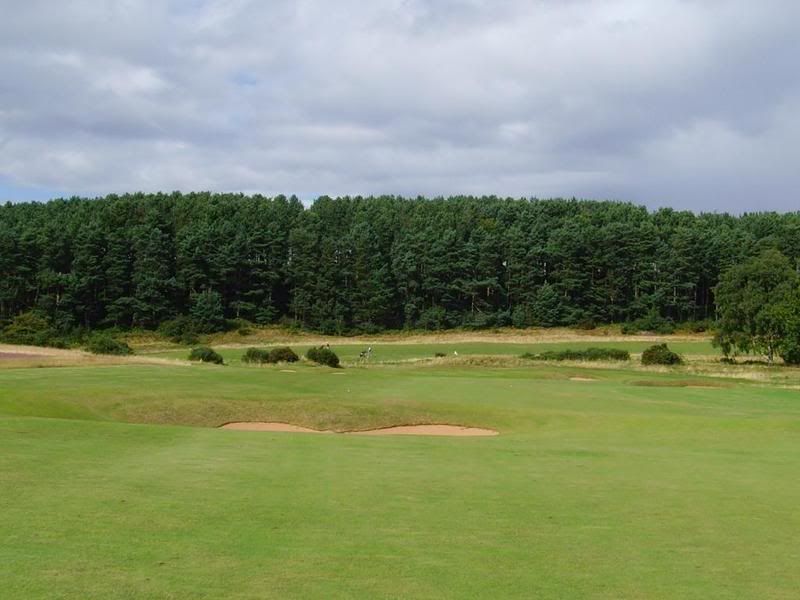 Hole 5, par 3
Hole 5, par 3Blue 189 yards
Yellow 165 yards
A fairly innocent looking par 3, though often played into the wind and surrounded by bunkers it can be tricky to get your par here. When Darwin played the course, this was a short par 4, but he did mention the “pretty background of trees and water” much as it is today.
Edit August09: New picture of this hole added.
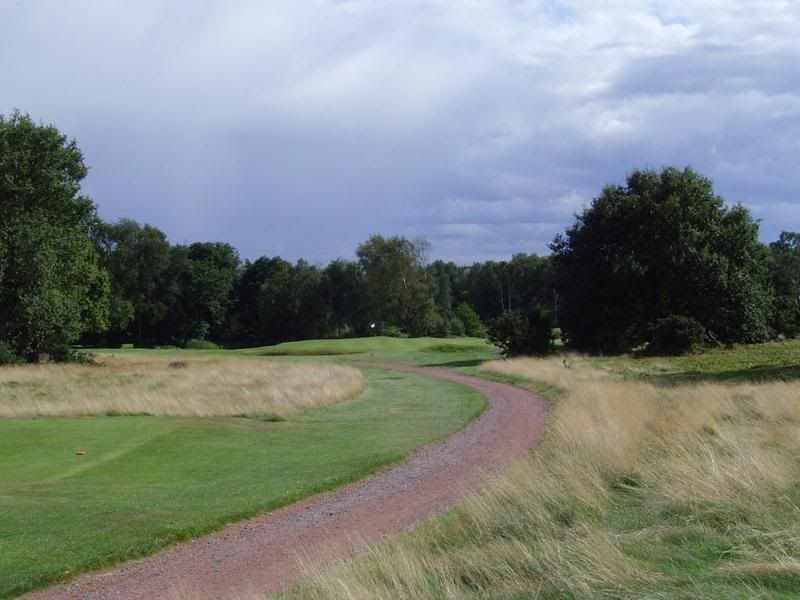 Hole 6, par 5
Hole 6, par 5Blue 582 yards
Yellow 516 yards
Quite a difference here between the yellow and the blue tees. From the yellows, you are in front of this pond, and either play left of the bunkers to give yourself a view of what is ahead, or you could try and fly the bunkers. From the blues you are a lot further back, and the setting for the tee is a little beauty. I have to admit that this was another hole where a good drive was just short of the bunkers, which may explain why I was managing a good score, with the trouble out of range!
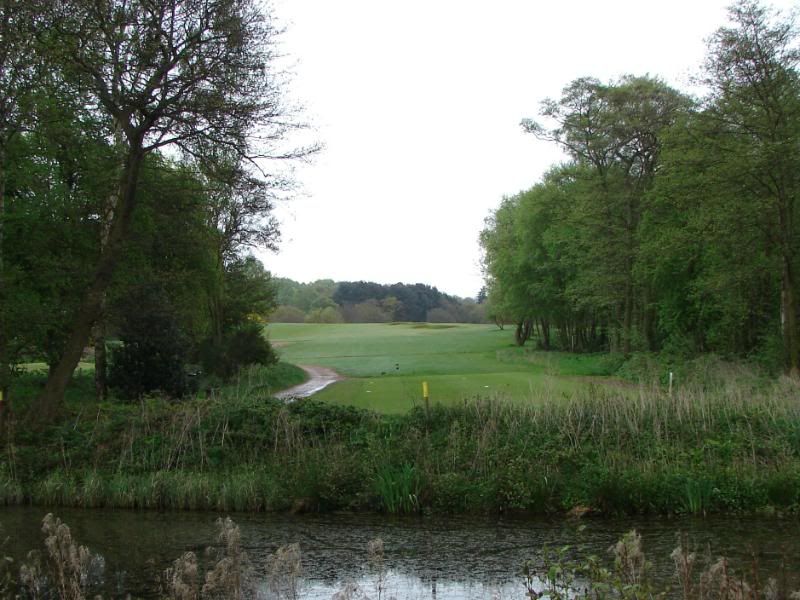
If you can get it up to the bunkers, you get a good view of the hole
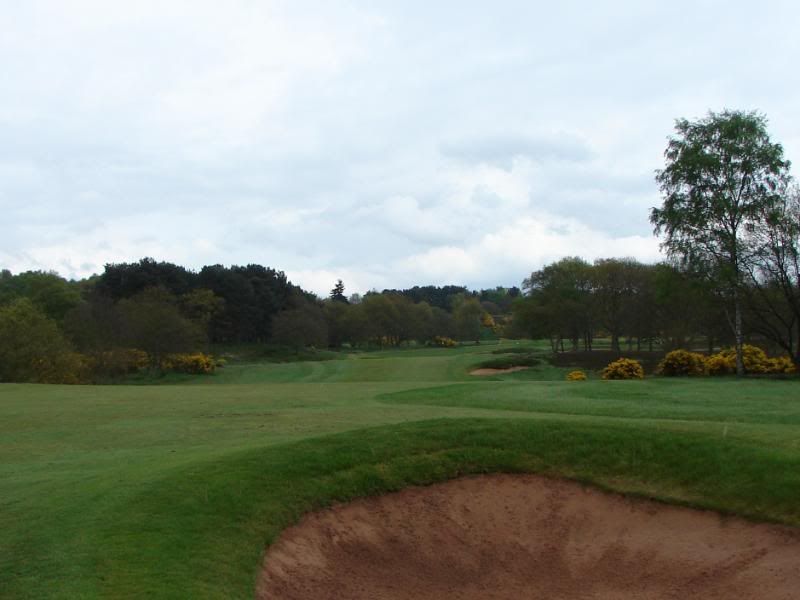
The green slopes back to front and left to right, with bunkers short left and right, as well as a hollow short right.
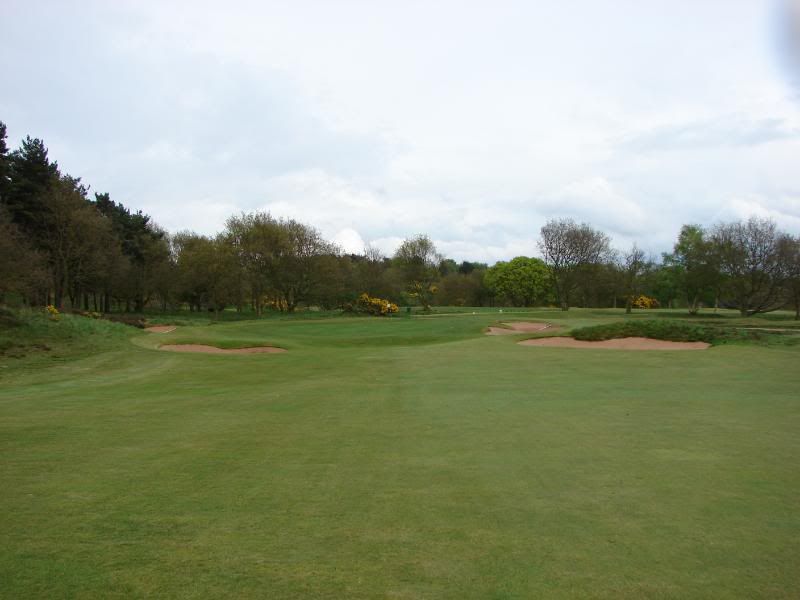 Hole 7, par 4
Hole 7, par 4Blue 404 yards
Yellow 388 yards
This hole could be considered a bit of breather, but you have to be straight off the tee to really feel it as one, as this is one of the holes where the trees really do encroach. All the tees here are pretty close to each other. There is no room to extend the blues backwards here as through the trees you will be able to see the 15th fairway running behind it. You drive into a small hollow, or just through it where there is a fairway bunker to the left.
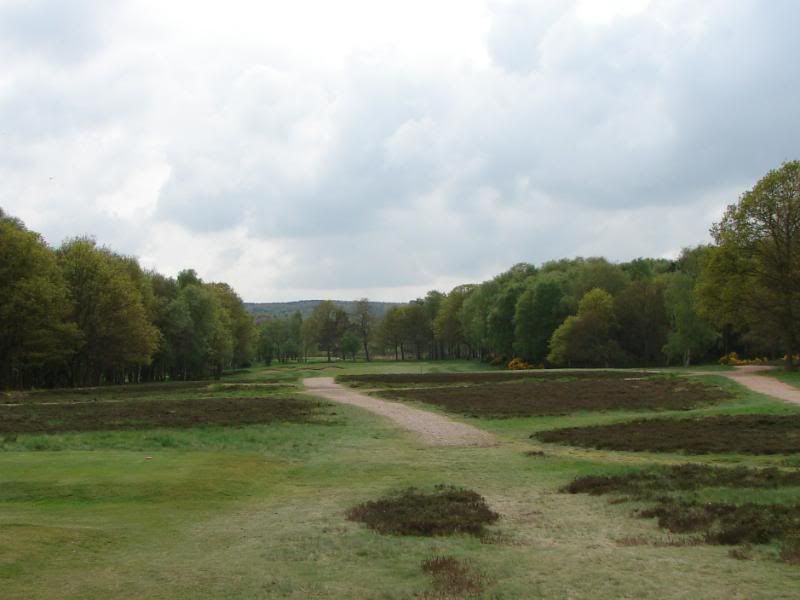
The green is protected short left by several bunkers so the best angle for an approach is probably from the right of the fairway, giving you a full view up the green
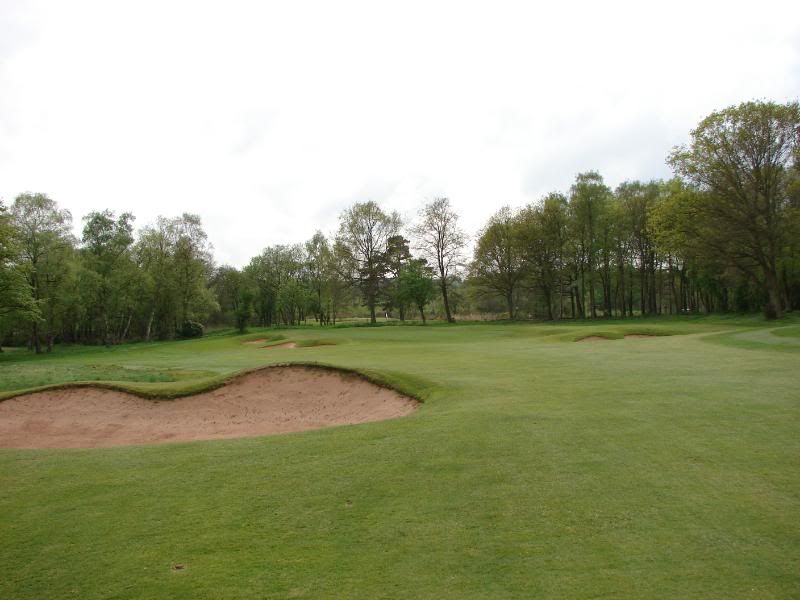 Hole 8, par 4
Hole 8, par 4Blue 408 yards
Yellow 357 yards
Holy Well
This is probably the hole at Hollinwell that you will have heard of? The drive from the back tees is across a lake, between mature trees and though if you are playing from these back tees this shouldn’t be too much of a challenge, the setting is beautiful. You really need to challenge the trees on the right, or fade the ball from the tee, as this hole doglegs from left to right from here.
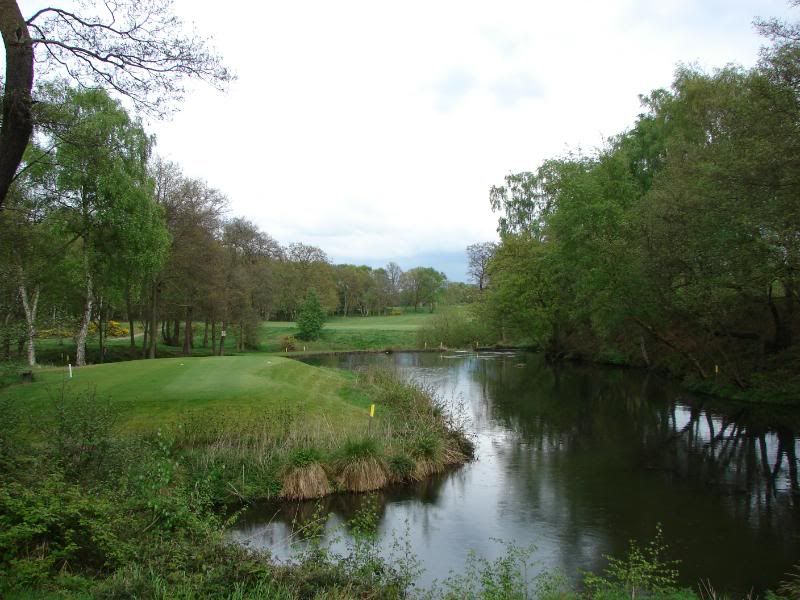
From this back tee you meander back through the woods towards the fairway, but you really must stop at this point for a drink. This is the holy well from where the courses name is derived, the Hollinwell, and it is marked by a stone tablet.
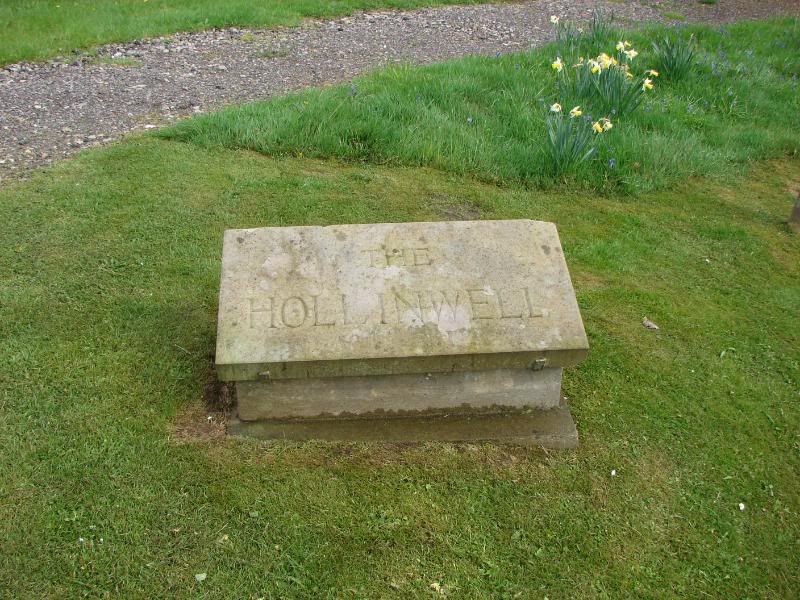
You work your way down some narrow stone steps for a drink of cold fresh water. The monks at nearby Newstead Abbey are believed to have used this spring as a water source many years ago, and its also been used by the club in the past to keep slightly stronger drinks cool!
Here is our host, taking a drink from the small metal cup provided
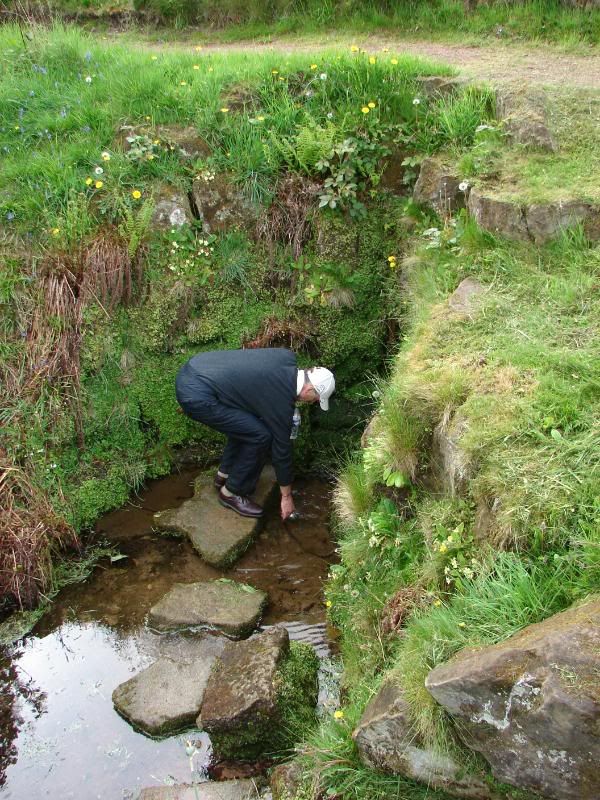
The yellow tee is a little disappointing in comparison to that of the blues or whites, as the lake is not in play and the hole is much shorter and straighter. This is the view looking back from the fairway with back tees and lake to the left, the Hollinwell in the woods in the middle, and yellow tees with 7th green behind, to the right
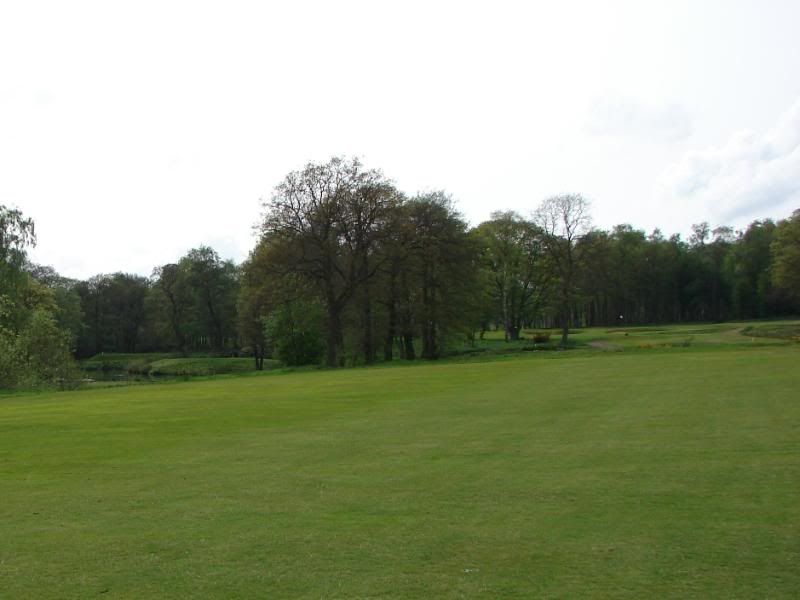 Hole 9, par 3
Hole 9, par 3Blue 178 yards
Yellow 149 yards
By the tee here is the small refreshments hut with its “Hollinwell Halt” sign, dating back from when the course originally had its own stop along the railways line. At the formation of the course here at Hollinwell, a new station halt was built, a reasonable return fair from Nottingham was agreed and a telephone link from station to clubhouse provided so that member could be informed when their train was approaching.
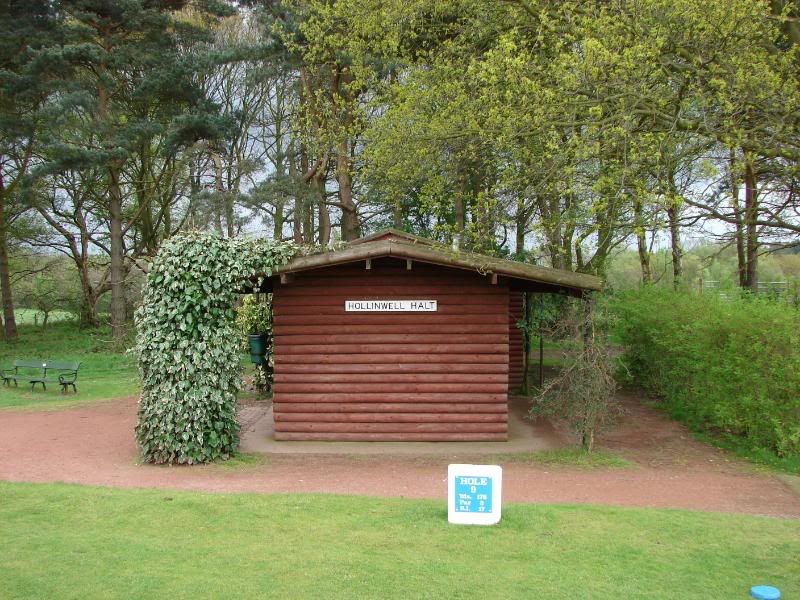
The green on this par 3 sits in front of a wonderful gorse covered hill and is surrounded by bunkers
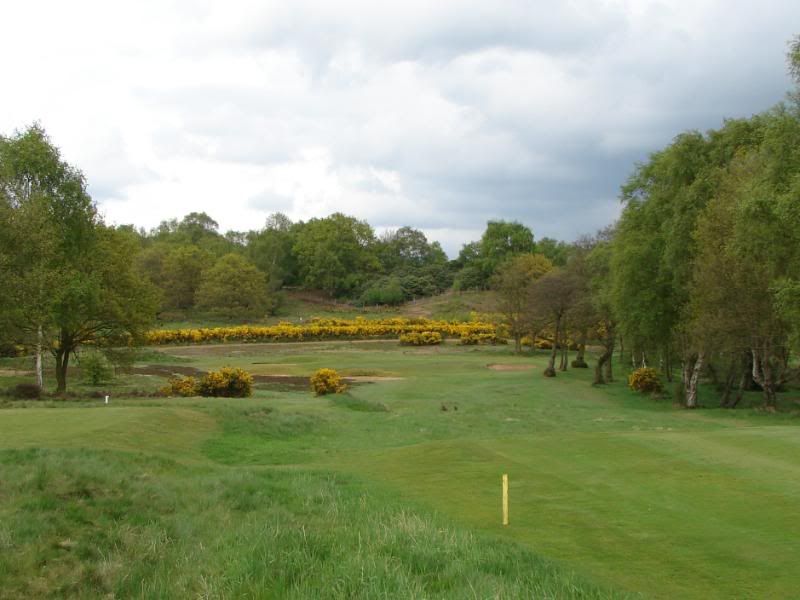
So that’s the front nine holes, if you have played off the blue tees then you have just played a challenging, but not impossible, 3,609 yards. If from the yellow then 3,250 yards. Both to a par of 36.
Back nine to follow shortly...